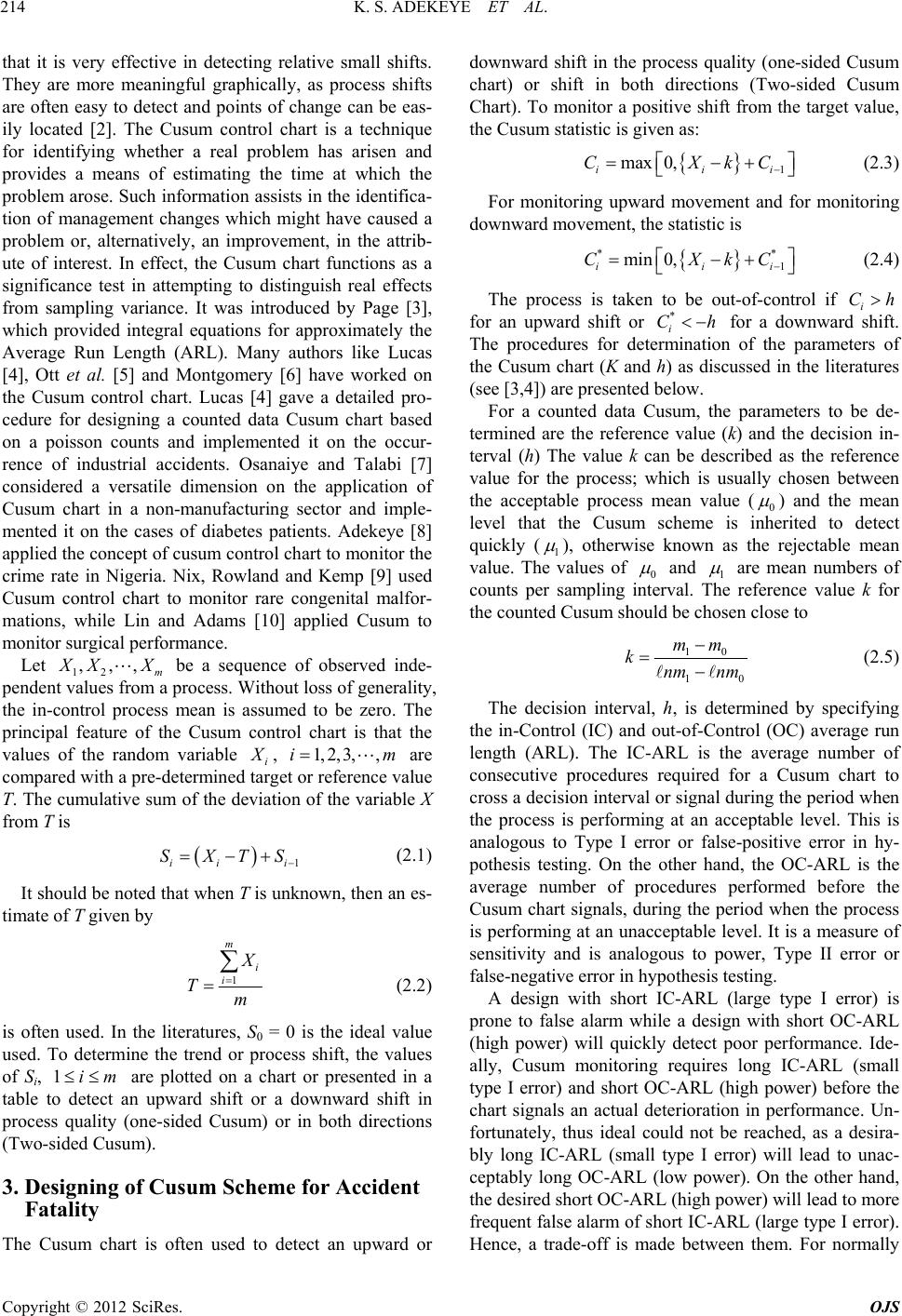
K. S. ADEKEYE ET AL.
214
that it is very effective in detecting relative small shifts.
They are more meaningful graphically, as process shifts
are often easy to detect and points of change can be eas-
ily located [2]. The Cusum control chart is a technique
for identifying whether a real problem has arisen and
provides a means of estimating the time at which the
problem arose. Such information assists in the identifica-
tion of management changes which might have caused a
problem or, alternatively, an improvement, in the attrib-
ute of interest. In effect, the Cusum chart functions as a
significance test in attempting to distinguish real effects
from sampling variance. It was introduced by Page [3],
which provided integral equations for approximately the
Average Run Length (ARL). Many authors like Lucas
[4], Ott et al. [5] and Montgomery [6] have worked on
the Cusum control chart. Lucas [4] gave a detailed pro-
cedure for designing a counted data Cusum chart based
on a poisson counts and implemented it on the occur-
rence of industrial accidents. Osanaiye and Talabi [7]
considered a versatile dimension on the application of
Cusum chart in a non-manufacturing sector and imple-
mented it on the cases of diabetes patients. Adekeye [8]
applied the concept of cusu m control chart to monitor the
crime rate in Nigeria. Nix, Rowland and Kemp [9] used
Cusum control chart to monitor rare congenital malfor-
mations, while Lin and Adams [10] applied Cusum to
monitor surgical performance.
Let 12 m
,,,
XX be a sequence of observed inde-
pendent valu es from a process. Without loss of generality,
the in-control process mean is assumed to be zero. The
principal feature of the Cusum control chart is that the
values of the random variable i
, are
compared with a pre-determined target or reference value
T. The cumulative sum of the deviation of the variable X
from T is
1,2, 3,,im
1ii i
SXTS
(2.1)
It should be noted that when T is unknown, then an es-
timate of T given by
1
m
i
i
Tm
1im
(2.2)
is often used. In the literatures, S0 = 0 is the ideal value
used. To determine the trend or process shift, the values
of Si, are plotted on a chart or presented in a
table to detect an upward shift or a downward shift in
process quality (one-sided Cusum) or in both directions
(Two-sided Cusum).
3. Designing of Cusum Scheme for Accident
Fatality
The Cusum chart is often used to detect an upward or
downward shift in the process quality (one-sided Cusum
chart) or shift in both directions (Two-sided Cusum
Chart). To monitor a positive shift from the target value,
the Cusum statistic is given as:
1
max 0,
iii
CXkC
(2.3)
For monitoring upward movement and for monitoring
downward movement, the statistic is
**
1
min 0,
iii
CXkC
Ch
*
Ch
(2.4)
The process is taken to be out-of-control if i
for an upward shift or i for a downward shift.
The procedures for determination of the parameters of
the Cusum chart (K and h) as discussed in the literatures
(see [3,4]) are presented below.
For a counted data Cusum, the parameters to be de-
termined are the reference value (k) and the decision in-
terval (h) The value k can be described as the reference
value for the process; which is usually chosen between
the acceptable process mean value (0
) and the mean
level that the Cusum scheme is inherited to detect
quickly (1
), otherwise known as the rejectable mean
value. The values of 0
and 1
are mean numbers of
counts per sampling interval. The reference value k for
the counted Cusum should be chosen close to
10
10
mm
knm nm
(2.5)
The decision interval, h, is determined by specifying
the in-Control (IC) and out-of-Control (OC) average run
length (ARL). The IC-ARL is the average number of
consecutive procedures required for a Cusum chart to
cross a decision interval or signal during the period when
the process is performing at an acceptable level. This is
analogous to Type I error or false-positive error in hy-
pothesis testing. On the other hand, the OC-ARL is the
average number of procedures performed before the
Cusum chart signals, during the period when the process
is performing at an unacceptable level. It is a measure of
sensitivity and is analogous to power, Type II error or
false-negative error in hypothesis testing.
A design with short IC-ARL (large type I error) is
prone to false alarm while a design with short OC-ARL
(high power) will quickly detect poor performance. Ide-
ally, Cusum monitoring requires long IC-ARL (small
type I error) and short OC-ARL (high power) before the
chart signals an actual deterioration in performance. Un-
fortunately, thus ideal could not be reached, as a desira-
bly long IC-ARL (small type I error) will lead to unac-
ceptably long OC-ARL (low power). On the other hand,
the desired short OC-ARL (high power) will lead to more
frequent false alarm of short IC-ARL (large type I error).
Hence, a trade-off is made between them. For normally
Copyright © 2012 SciRes. OJS